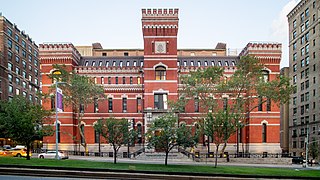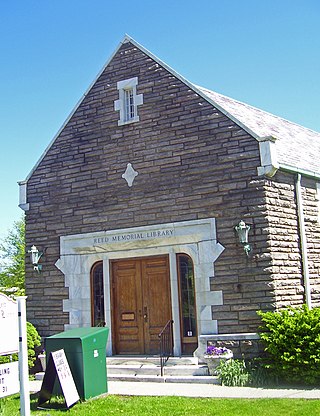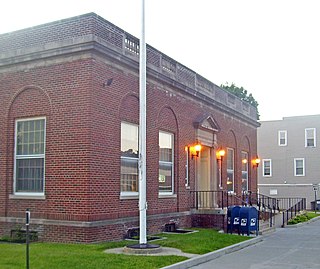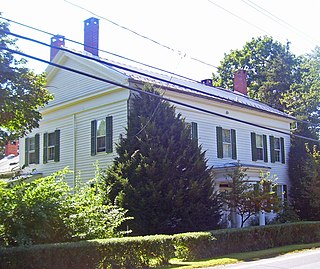
The Park Avenue Armory, also known as the 7th Regiment Armory, is a historic National Guard armory building at 643 Park Avenue in the Upper East Side neighborhood of Manhattan in New York City. Designed in the Gothic Revival style by Charles Clinton for the 7th New York Militia Regiment, the Park Avenue Armory was completed in 1880, with two expansions in the early 20th century. The building and its interior are New York City designated landmarks, and the structure was made a National Historic Landmark in 1986. Since 2006, it has been the home of the Park Avenue Armory Conservancy, which leased the building for 99 years from the New York state government. The 53rd Digital Liaison Detachment of the New York Army National Guard, the Veterans of the 7th Regiment, and the Lenox Hill Neighborhood House also occupy parts of the armory.

The U.S. Post Office in Goshen, New York, United States, is located on Grand Street downtown in the village of Goshen. It serves ZIP Code 10924, roughly contiguous with the village and town. The brick Colonial Revival building was completed in 1936, and added to the National Register of Historic Places in 1989.

The former Alexander Classical School, today Alexander Town Hall, is located on Buffalo Street in Alexander, New York, United States. It is a three-story cobblestone building erected in the 1830s.

Reed Memorial Library is located at the junction of US 6 and NY 52 in Carmel, New York, United States. It is the oldest library building in Putnam County, and was listed on the National Register of Historic Places in 1980.

Schenectady City Hall is the seat of government of the city of Schenectady, New York, United States. Designed by McKim, Mead, and White, the building was constructed between 1931 and 1933. It is located on the block between Clinton, Franklin, Jay and Liberty streets. It is built in a revival of the Federal Style, the dominant style of American architecture from 1780 to 1830. Its most prominent features include the square clock tower, with its gold-leaf dome and weathervane, and the Ionic neoclassical portico. It houses not only city government but the local office of U.S. Rep. Paul Tonko.

The Boice House is located on Fair Street in Kingston, New York, United States. It was first built around 1850 in the Greek Revival architectural style.

The Medina Armory is located on Pearl Street in Medina, New York, United States. It is a large stone building constructed at the beginning of the 20th century.

The Le Roy House and Union Free School are located on East Main Street in Le Roy, New York, United States. The house is a stucco-faced stone building in the Greek Revival architectural style. It was originally a land office, expanded in two stages during the 19th century by its builder, Jacob Le Roy, an early settler for whom the village is named. In the rear of the property is the village's first schoolhouse, a stone building from the end of the 19th century.

The Foster Building, originally the Hotel Foster, is located on State Street in Schenectady, New York, United States. It is a commercial building in the Beaux-Arts architectural style.

Elston Hall, formerly the Hotel Van Curler, is located on Washington Street in the city of Schenectady, New York, United States. It is a tall brick building constructed in 1925 in the Classical Revival architectural style.

The U.S. Post Office in Scotia, New York, is located on Mohawk Avenue in the middle of the village. It is a brick Colonial Revival structure built at the end of the 1930s, serving the 12302 ZIP Code, which covers the village and some surrounding areas of the Town of Glenville.

The 369th Regiment Armory is a historic National Guard Armory building located at 2366 Fifth Avenue, between West 142nd and 143rd Streets, in Harlem, Manhattan, New York City. It was built for the 369th Regiment, also known as the "Harlem Hellfighters", founded in 1913 as the first National Guard unit in New York State composed solely of African-Americans. It later became home to the 369th Sustainment Brigade.

The U.S. Post Office in Hoosick Falls, New York, is located on Main Street a block south of downtown. It is a brick building erected in the mid-1920s, serving the 12090 ZIP Code, which covers the village of Hoosick Falls and surrounding portions of the Town of Hoosick.

The Hoosick Falls Armory is located along Church Street in Hoosick Falls, New York, United States. It is a red brick building with castellated tower dating to the late 19th century.

The Fort Washington Avenue Armory, also known as the Fort Washington Armory, The Armory, and the 22nd Regiment Armory, is a historic 5,000-seat arena and armory building located at 216 Fort Washington Avenue, between West 168th and 169th Streets, in the Washington Heights neighborhood of Manhattan, New York City. It is a brick Classical Revival building with Romanesque Revival elements, such as the entrance arch, and is currently home to the non-profit Armory Foundation, National Track and Field Hall of Fame, Nike Track and Field Center, and other organizations including the Police Athletic League of New York City.

The Stephen Hogeboom House is located on NY 23B in Claverack, New York, United States. It is a frame Georgian-style house built in the late 18th century.

The former Harmanus Bleecker Library is located at the intersection of Washington Avenue and Dove Street in Albany, New York, United States. It is a brick and stone Classical Revival building constructed in the 1920s. In 1996 it was listed on the National Register of Historic Places.

The New Scotland Avenue Armory is located on New Scotland Avenue in Albany, New York, United States. It is a large brick building constructed in the early 20th century. In 1994 it was listed on the National Register of Historic Places, one of two armories in the city of Albany to be so designated.

The 14th Regiment Armory, also known as the Eighth Avenue Armory and the Park Slope Armory, is a historic National Guard armory building located on Eighth Avenue between 14th and 15th Streets in the South Slope neighborhood of Brooklyn, New York City, United States. The building is a brick and stone castle-like structure, and designed to be reminiscent of medieval military structures in Europe. It was built in 1891–95 and was designed in the Late Victorian style by William A. Mundell.

The First Battery Armory, also known as the 102nd Medical Armory and the State Armory, is a historic National Guard armory building at 56 West 66th Street, between Central Park West and Columbus Avenue, on the Upper West Side of Manhattan in New York City, United States. The building was constructed between 1901 and 1904 and was designed by Arthur J. Horgan and Vincent J. Slattery in multiple revival architectural styles. It is composed of a symmetrical brick-and-granite headhouse to the north and a drill hall to the south. The armory is a New York City designated landmark and is listed on the National Register of Historic Places.






















